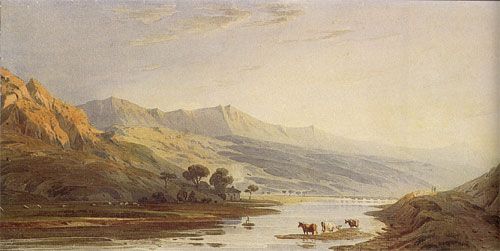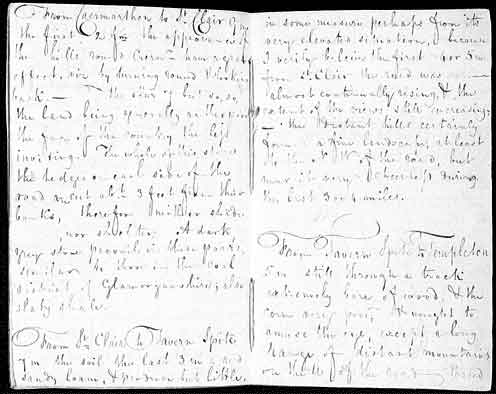A Journey through Wales in 1819
A Grand Tour of Europe

Cader Idris, a watercolour by John Varley in the Department of Art, Amgueddfa Cymru. The writer described Cadair Idris as 'rearing his dark majestic head above his gigantic brethren'.
The Library at Amgueddfa Cymru contains a large number of historically important books, including a large number of accounts of tours of Wales published in the late 18th and early 19th centuries. Many of these were originally collected for their illustrations. Equally important, however, is the actual text that accompanies them.
In the 18th century, it was traditional for the aristocracy and the wealthy to go on a “Grand Tour of Europe” as the culmination of their classical education, visiting the cultural centres of Paris, Venice, Florence, and Rome. The Napoleonic Wars of 1790-1815 brought a temporary halt to this and instead they began to travel at home.
The accounts of such travels through Wales contain information on a very wide range of topics. They reveal information on the state of the roads, inns and hotels, descriptions of great houses and their contents, agriculture, industry, local customs and Welsh society in general. Many observers also commented on the natural history of Wales, sometimes giving lists of the plants and animals encountered.
A Grand Tour of Wales
The Library at the Museum has in its collections three 19th-century diaries dated 1819, 1841 and 1844, which were written by Lynn Dewing (1773-1854) from Norfolk
From Cardiff to Swansea

Two pages from the first part of the 1819 diary, describing the St Clears area in Carmarthenshire
The first tour commenced at Bristol on 29th May 1819, with a journey by ship to Cardiff, a town with well planted walks about the castle, along with the iron foundries whose products were brought down the Glamorgan Canal.
The writer was one of the few visitors to Llandaff who had a kind word to say about John Wood's rebuilt cathedral, left incomplete in 1752.
He seemed very impressed with Swansea with its 'well-built & respectable houses, & shops, and several good streets'. In the areas around Cardiff and Swansea he wrote that the 'houses of the poor' were far neater in appearance, with their well-kept whitewashed walls, than their counterparts in England, although no comment was made on the state of the interiors.
Flowers in the Graveyards
At Kidwelly, the writer made a comment that also appears in other accounts of journeys through Wales and was about the decorating of graves with flowers, something that is taken for granted today. 'I observed in several of the Church-yards the old Welsh custom still prevails of planting flowers upon the graves of their relatives.' It was not until later in the 19th century that placing flowers on graves in England became common.
A lift to Aberystwyth
The time taken for the 1819 tour suggests that the diarist walked most of the way. He did ride in a fish-cart in order to reach Aberystwyth, and had to hire a man to carry his luggage for some 23 miles. Aberystwyth is described as 'a very neat sea-port & bathing place. The views from the Parade are very beautiful, both land & sea.'
A journey up Snowdon
The traveller then headed north. He went on to climb Snowdon on one of the few days in his diary that he actually dates.
'Friday 16th July 1819' from the inn at Glyn Gwyllyn [to the west of Snowdon] on my ten toes at half past four o'clock to ascent SNOWDEN [sic]. It was my intention to start at 2 o'clock, in order to reach the top in time to see the sun rise, which I am told is a fine sight indeed from Snowdon, but I was so annoyed with the noise of 4 or 5 welsh miners for 3 hours after I was in bed, that I could not get a wink of sleep before one o'clock.'
Near the summit he noted a recently opened copper mine which was being worked by six Cornish miners.
The extracts above are but a small sample from the beginning of the second volume for 1819. The diaries serve to contribute further to our understanding of Wales in the early 19th century.
Further reading
Crossley Evans, M. J., ‘Lynn Dewing, an unknown Lakeland traveller, and his journals 1817-1847, part 1., in Transactions of the Cumberland and Westmorland Antiquarian and Archaeological Society, 3rd ser., vol. IX, 2009, pp. 187-216
Comments - (1)
In the vcc library website there is letter describing the new hobby horse as being descended from the Welsh go cart.
This is from a published letter in a magazine e of 1819.( first page of vcc library about item 10)
I would like to see this vehicle,do you have a picture?
The bicycle historians view the machine of von drais as first.i believe,from many references, that this is incorrect .
The unsteerable hobby horse also existed but we have no pre dating proof.it strikes me as unrealistic to believe that it came after.
Any help much appreciated,James Peatling